
Summon Night Swordcraft Story / Craft Sword Monogatari (2003) - Gameboy Advance
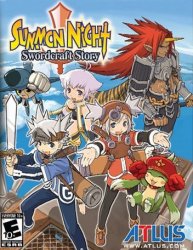
American Cover
|
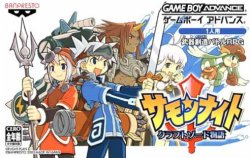
Japanese Cover
|
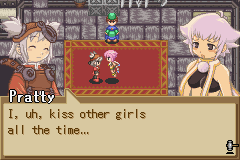
Summon Night Swordcraft Story
|
|
In making the transition to the Gameboy Advance, Summon Night sheds it tactical RPG trappings and opts to turn it into a unique blend of dungeon crawling and action gaming. Much like the console versions, you pick one of two characters, who are then assigned one of four Guardian Beasts based on some questions asked early in the game. And again, there are nighttime sequences where you can pick a character to converse with.
Despite your protagonist choice, the plot is essentially the same - as the son/daughter of a famous Craftsknight, it's up to you to face off against other fighters in a huge tournament.
Characters
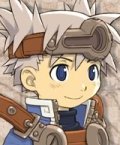
|
Cleru
The male protagonist.
|
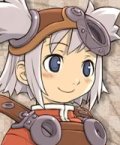
|
Pratty
The female protagonist.
|
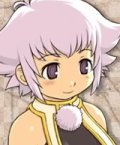
|
Sugar
A fairy. Seems to have bisexual tendencies if you play as Pratty.
|
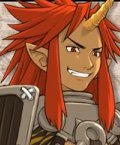
|
Rasho
An arrogant oni. Appears to have a crush on the main character's mom.
|
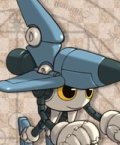
|
Zantek
A flying mech thing. Speaks in symbols which only your character can understand.
|
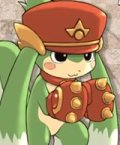
|
Kutty
A cute little green beast. Speaks in mostly unintelligible Pokemon-ese.
|
You spend a lot of time running around town or exploring the sole dungeon in the game, a huge, expansive underground maze filled with monsters and treasures. As the title implies, you can find materials to make weapons, which is required to win some of the tougher tournament battles. Although the dungeon crawling is handled like your typical JRPG, the random battles are side-scrolling action sequences similar to the Namco's Tales Of... series. Other than your Guardian Beast, who can be called out to cast various spells, you never get any other companions, and only command the main character. The controls are pretty tight (other than making you jump by pressing "Up"), but they tire out pretty quickly - you're either mashing buttons or timing your defense moves correctly, neither of which are very fun in the long run. Weapons can break mid-battle too, requiring that you switch to back-up armaments, but they regenerate after every fight.
I figured the dialogue on the console Summon Night games was only excessive because it was in Japanese. But no, it's overwhelming when it's in English, and most of the plot is pretty boring. The only saving grace is some clever writing and amusing lines spoken by some of the NPCs, inserted courtesy of Atlus' excellent localization staff. It's a bit odd that the game was released in the USA in 2006, three years after the Japanese release. The graphics are generally pretty drab, and the music quality is extremely poor. It's nice to see the series come to America, but ultimately it's a bit too longwinded and simplistic to be too gratifying. At least it offers a unique experience, and it's certainly not any worse than most non-ported GBA RPGs.
|
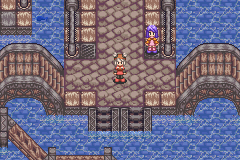
Summon Night Swordcraft Story
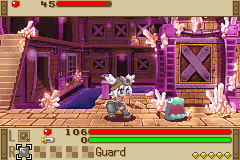
Summon Night Swordcraft Story
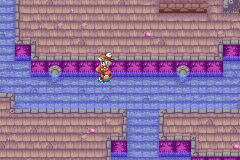
Summon Night Swordcraft Story
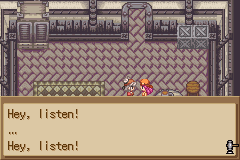
Summon Night Swordcraft Story
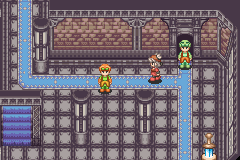
Summon Night Swordcraft Story
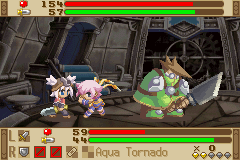
Summon Night Swordcraft Story
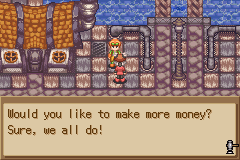
Summon Night Swordcraft Story
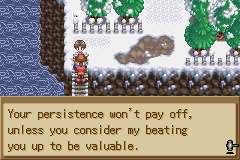
Summon Night Swordcraft Story
|
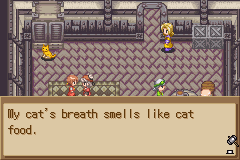
|
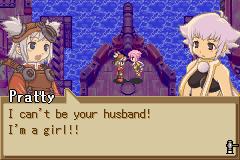
|
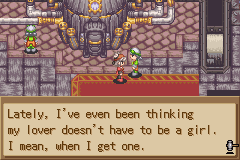
|
|
Summon Night Swordcraft Story
|
Summon Night Swordcraft Story
|
Summon Night Swordcraft Story
|
Summon Night Swordcraft Story 2 / Craft Sword Monogatari 2 (2004) - Gameboy Advance
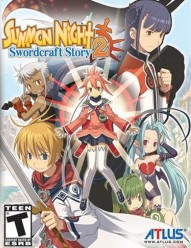
American Cover
|
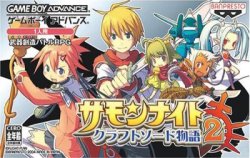
Japanese Cover
|
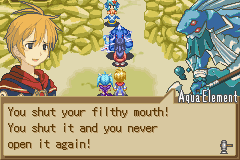
Summon Night Swordcraft Story
|
|
In Summon Night Swordcraft Story 2, you play as an orphan who watches as a great evil has been reawoken - by your former best friend, no less. It's up to them to make sure this long sealed monster stays dead.
Characters
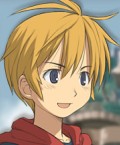
|
Edgar
The male protagonist.
|
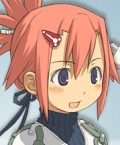
|
Aera
The female protagonist.
|
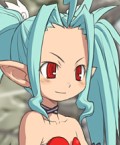
|
Dinah
A schizophrenic devil/angel girl. Pretty ripped off from Etna of Disgaea.
|
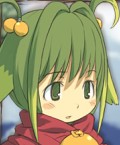
|
Arno
A somewhat dense beast child. Probably a boy, but this point is of contention.
|
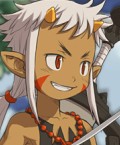
|
Leki
A mischievous oni boy.
|
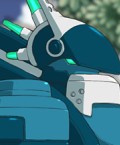
|
Y-XE-LD
A fearsome mechanical being.
|
Essentially Swordcraft Story 2 is the same as its predecessor with some minor improvements. You can switch between weapons when exploring, which can be used to cut down different obstacles. Also, your weapons don't regenerate after combat, forcing you to return to your home base every once in awhile to repair them. There's no longer a single dungeon to explore, as you can leave the central town and explore different areas. It's still pretty linear, so functionally it's the same, but it looks and feels less restrictive. The music quality is slightly better, and the writing is roughly about par with the original game. This game was also released in America in 2006, just a few months after the first, and there's really not that much new to justify checking it out.
|
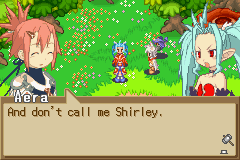
Summon Night Swordcraft Story 2
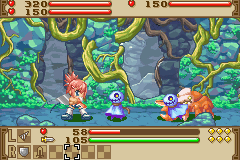
Summon Night Swordcraft Story 2
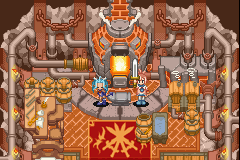
Summon Night Swordcraft Story 2
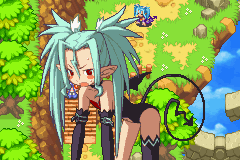
Summon Night Swordcraft Story 2
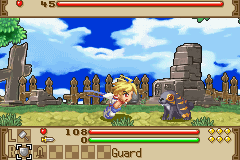
Summon Night Swordcraft Story 2
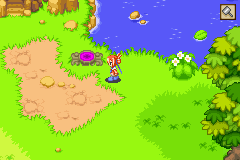
Summon Night Swordcraft Story 2
|
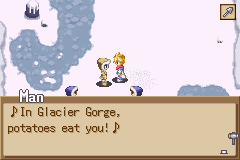
|
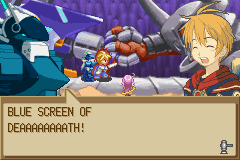
|
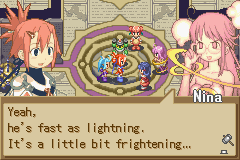
|
|
Summon Night Swordcraft Story 2
|
Summon Night Swordcraft Story 2
|
Summon Night Swordcraft Story 2
|
Summon Night Craft Sword Monogatari: Hajimari no Ishi (2005) - Gameboy Advance
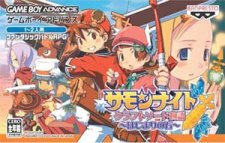
Japanese Cover
|
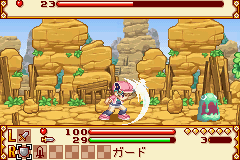
Hajimari no Ishi
|
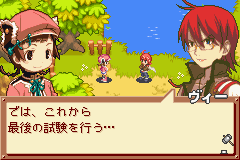
Hajimari no Ishi
|
|
The third and final GBA game, Hajimari no Ishi ("The Stone of Beginnings") tells the story of a young Craftsknight whose former master had been slain by a Guardian Beast gone awry. This same Guardian Beast returns and later joins the protagonist in repentance, while partnering with them on a quest to save the world.
Characters
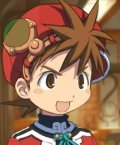
|
Ritchburn
The male protagonist. His nickname is Ritchy.
|
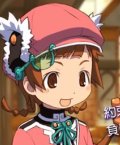
|
Rifmonica
The female protagonist. Her nickname is Rif.
|
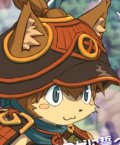
|
Enzi
Some kind of flying cat-thing.
|
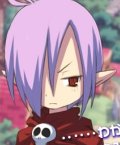
|
Killfith
Swordcraft Story 2 had a demon chick. This one has a demon dude.
|
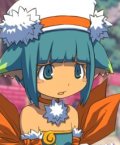
|
Rufeel
A cute little beast girl.
|
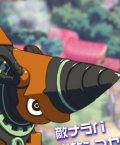
|
Rundor
Another one of the mechanical beings, this time with a drill for a nose.
|
The only real change in this installment is that the Guardian Beasts can be summoned into combat and can actually be controlled, as opposed to simply dropping in and casting spells. This one never saw a release outside of Japan.
|
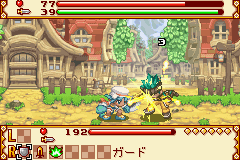
Hajimari no Ishi
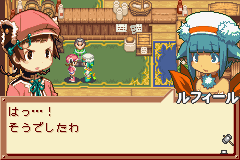
Hajimari no Ishi
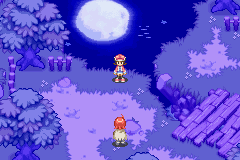
Hajimari no Ishi
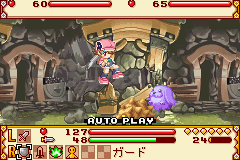
Hajimari no Ishi
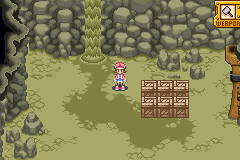
Hajimari no Ishi
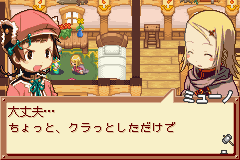
Hajimari no Ishi
|
|
In addition to Summon Night, Flight Plan also created another series of SRPGs called Black Matrix. Various version appear on the Playstation, Saturn, Dreamcast, GBA and PS2. They're pretty similar, although they're a lot darker and feature lots of angels and stuff like that. It also has a weird hip hop soundtrack. Additionally, Flight Plan's newest PS2 SRPG, Dragon Shadow Spell, seems to ring pretty closely to Summon Night.
Honestly, as a whole, the Summon Night series seems a little bit lazy. The games themselves are pretty decent when taken by themselves, but playing them one after another, they all kind of blend together. I'd definitely recommend that you play at least one of them if you're into SRPGs. However, at times, they seem more like devices to tell a story, as evidenced by how little the games have changed over each installment. One review I saw on Amazon Japan dubbed Summon Night a "character game" - a term that generally describes mediocre games aimed towards a specific fanbase, usually licensed titles. After all, it's pretty inexpensive to create a base gameplay engine, then recycle it over and over, only changing the graphics, characters and story. I supposed it's a testament to Summon Night's charm that it manages to create attractive, likable characters without being based on any prior anime or manga, although it often feels like it could have been.
Links
Summon Night Official Web Site A comprehensive look at all of the games and characters.
Wikipedia Japan - Summon Night Specific info on each game.
Siliconera - Summon Night 4 A longer review I wrote for SN4.
|
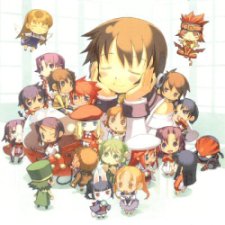
Summon Night Soundtrack
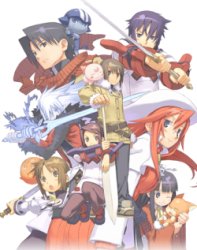
Summon Night Fan Art
|
Back to the index
Back to Page 5









































